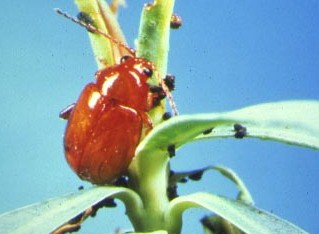Insect: Beetle (Coleoptera: Chrysomelidae)
Brown dot leafy spurge flea beetle
Biological Control Links Photos: Beetle Apthona sp. Larva Adult 1
 Photo: Biological
Weed Control slide show, Reeves Petrov.
Photo: Biological
Weed Control slide show, Reeves Petrov. Original sources: Europe, Austria, Hungary, and Italy. (1)
Biology: One generation per year. (1)
Over wintering stages: Mature larval. (1)
Egg stage: Eggs are generally lay on the lower stem next to the soil or on the lower stem during July August, and September. They hatch in about 13 days. (1)
Larval stage: The larvae are active from August until early spring. There are three Larval instars, the first lasts about eight days (under ideal conditions), the second lasts 25 to 30 days, and the final instar requires about 45 days. A cold period is needed to cause the mature larvae to pupate. The larval head is well sclerotized (has a hard covering) and sub compressed and the body is grub-like and whitish in color. (1)
Pupa stage: Pupation Lasts about 20 days within a soil cell, from late spring to early summer.
Adult stage: Adult beetles are found on the leafy spurge plants from July until about September with many individuals surviving and laying eggs for three to four months. Adult are oval and brown and measure about 3.2 mm (0.13 in.) long. (1)
Effect:
Destructive stages: Adult and larval. The larva have the greatest effect on the plant.
Plant species: Leafy spurge, (Euphorbia esula). (1)
Host Impact (method/focus): Adult feeding on the leaves causes the plant to loose some root reserves. The larval feeding on the root hairs and young roots have the greatest effect by reducing the plants ability to uptake water and nutrients. The plant desiccates (dries out). This decreases the height attained by the plant, delays the flowering time, and causes the plant to take it's nourishment from the taproot for other reasons than growth and reproduction. Over prolonged periods, continuous pressure by the beetles weakens the plant and can cause death of this hard to control noxious weed. (1)
Favorable/unfavorable release habitats: Grasslands infested with leafy spurge. Areas with flowering spurge stems that are tall and with a density between 50 and 125 stems per square meter, and with soils between 40% to 60% sand. These requirements are often found on dry alluvial fans. This flea beetle prefers warm, open, sunny areas and slightly more moist conditions that A. nigriscutis. (1,2)
It is now established in Colorado, Iowa, Idaho, Minnesota, Montana, Nebraska, Nevada, New Mexico, North Dakota, Oregon, South Dakota, Washington, Wisconsin, and Wyoming. (1)
How to redistribute:
Habitat: Areas with flowering spurge stems that are tall and with a density between 50 and 125 stems per square meter, and with soils between 40% to 60% sand. These requirements are often found on dry alluvial fans. This flea beetle prefers warm, open, sunny areas and slightly more moist conditions that A. nigriscutis. (1,2)
Dedistribution: Collect the beetles with a sweep net and transport them in a cooler with an ice pack. Within the cooler, the insects should be kept in paper breathable insect containers that are not directly touching the ice pack(s). After they are sorted, they can be shipped or stored on leaf material for several days if kept cool, or for several weeks under cool temperatures with with warm feeding and exersize periods every few days. Also, frozen roots and soil containing the larvae can be removed from the field in the winter and kept frozen for four to six weeks before the adults are desired. The beetles can then be reared at room temperature. (1)
Comments: After this insect is turned loose, leafy spurge plant density is gently reduced. Roots that are not attacked including the taproot are able to send up small new shoots to supply the sugars for root reserves. It is only through long term establishment of the beetle in a site favorable to beetle development that the lateral roots of leafy spurge will be destroyed, the taproots weakened, and many of the plants finally eliminated from the area. (1)
"This biocontrol agent is established near Whitehall, MT and is causing reduction of leafy spurge density on most sites." T. Breitenfeldt, WHS science teacher.
Links:
Beetle
Apthona sp. Larva
Brown-legged flea beetle
brown dot beetle
Feeding
Life
Habitat
Bio control
Adult
Over veiw
Bibliography
1. Rees, Norman, et, al., Ed., Biological Control of Weeds in the West, Western Society of Weed Science, in cooperation with USDA, ARS, MT Dept. of Ag, and MT State Univ., Bozeman, Color World Printers, Bozeman MT, Feb, 1996.
2. Hansen, Rick, Biological Control, A Guide to Natural Enemies in North America, Cornell Univ. [Online] Available: http://www.nysaes.cornell.edu/ent/biocontrol/weedfeeders/a.cyparissiae.html . Last modified March 17, 1998.
By: Scott Merkel Published By: Joe Wilson 2/15/2000. Updated By: Trista Zink 3-17-05
Back mtwow.org HOME